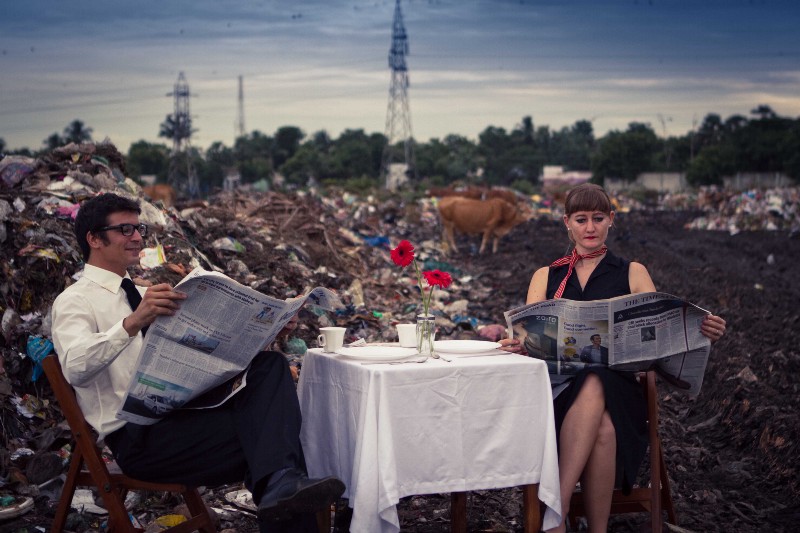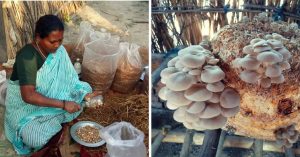TBI Blogs: Garbology Is the Most Interesting Subject in over 37 Schools in India. Find out Why.
Garbology uses colouring books, board games & activity-based learning to drive long-term behavioural change among school students, especially with regard to consumption & waste management.

Garbology uses colouring books, board games & activity-based learning to drive long-term behavioural change among school students, especially with regard to consumption & waste management.
Much of the problem of waste lies in our attitude and behaviour towards it. The economic reforms and liberalisation of the 90s kickstarted India’s transformation into a consumerist society. Our consumption patterns changed, but our education system and waste management infrastructure did not. When new forms of waste are thrust upon primitive systems, the result is the burgeoning problem of garbage; a common problem that plagues most cities today.
Participating in relief work in coastal Tamil Nadu after the devastating tsunami of 2004, Chandrah Nusselein found that a lack of awareness about proper waste management techniques as well as a lack of infrastructure compounded health problems among affected communities. She was convinced that the solution to the problem of garbage lay in large scale behaviour change through education and citizen empowerment.
Back home in Auroville, Chandrah began studying the township’s waste management systems and set about changing the way the community produced and managed its waste. In 2009, with her brother Ribhu Vohra, she organised the ‘Litter Free Auroville’ campaign. Over 2000 residents joined the clean-up drive and students of 17 local schools received educational material on waste management.
The response to the campaign was overwhelming. “All the schools returned, asking for such material to be included in their regular curriculum,”says Vohra. They found that after 6 months of using the educational material, students were not only adopting newly-learned behaviour themselves, but were also trying to change the consumption and waste disposal behaviour of their families.
Giving serious thought to the creation of educational material that schools could seamlessly integrate into their curriculum, Vohra and Nusselein formed WasteLess India in 2011.
The Auroville-based non-profit social enterprise educates school children about waste management; this empowers them to make long-term changes in their consumption habits as well as in their attitude and behaviour towards waste creation and disposal.

Photo Source
In 2012, WasteLess’s premier offering, ‘Garbology 101’ — 101 innovative games and activities for waste education — was born.
“We target children between the ages of 8 and 15 because that’s when they are curious and most interested in learning. They also stand to inherit the mess we are making today and they need to have the tools to clean it up,” says Vohra.
Children are also effective agents of behavioural change at the level of the household.
The Garbology toolkit combines physical tasks, card and board games, and colouring activities for different academic levels. Teachers can use the kits either to complement or substitute regular lessons for environmental education and social studies; it can also be taught as a stand-alone subject.

Photo Source
The activities are designed to address waste from diverse perspectives and offer an impressive range of themes for children to comprehend the inter-relatedness of waste with things around them.
Children go on 101 journeys through the complex world of waste, examining how and where it is produced, its impact on natural resources, the systems that handle and dispose it, and their role as consumers in reducing waste.
They upcycle used Tetrapaks into wallets while studying resource conservation and study the packaging on soft drinks to understand their environmental impact. They compare linear and cyclical economies, analyse advertisements and evaluate their consumption habits accordingly.
“Garbology does not enforce a particular behaviour but, by analysing a problem in different ways, empowers children with the knowledge to evaluate their choices and make the right choices while understanding their impact. This also gives them the power to explain their choices and influence others’ behaviour,” adds Nusselein.
To ensure compatability with the formal, tightly structured Indian school system, the flexible curriculum of Garbology was adapted and made easy for teachers to use and to allow for periodic learning assessments.
The WasteLess team also trains school teachers to understand and link different topics and use Garbology effectively.

Photo Source
“Integrating waste education into the school curriculum reinforces positive behaviour regularly and demonstrates that waste is an issue that needs to be addressed seriously,” emphasises Nusselein.
Garbology currently reaches 32,000 students in 37 private and aided schools in Andhra Pradesh, Delhi, Pondicherry, Madhya Pradesh, Kerala, Karnataka and Uttarakhand. It is also used by WasteLess’ NGO partners in educational programmes in their network of schools.
The impact of Garbology is evident in schools which, with the help of WasteLess, have begun waste segregation and composting, or have set up recycling units on their campuses, donating the proceeds from selling recyclable waste to developmental activities. “In one Chennai-based school, the children have now started a campaign to train their parents in waste segregation,” Nusselein says.

Similar Story

How Mushroom Cultivation Is Changing the Fortunes of Women in Rural India
Chattisgarh’s tribal communities, with limited job and economic opportunities, saw a significant chance when an organisation offered to train tribal women in starting a mushroom cultivation business. Jayashiree Elango explores further.
Read more >
For government schools where Garbology did not do well, WasteLess developed an innovative game called ‘Pick-it-Up.’ The game teaches children the economic value of recycling waste. With a handbook of activity-based lessons and accompanying card games, students learn the hierarchy of value of different categories of waste based on their recyclability. For example, metal and plastic waste has the highest value followed by paper and glass.
“We found that about 35% of India’s municipal solid waste can be sold to scrap dealers. But because people don’t separate waste at the source and are largely unaware about the value of different items, most recyclable waste does not reach these dealers and ends up, instead, in toxic dumpsites,” says Nusselein.
WasteLess’ first task while developing Pick-it-Up was to map the items bought and the rates offered by scrap dealers across 15 different locations across India.

Photo Source
“The aim of the game,” Vohra explains, “is to reinforce in children, and by extension, their parents, that there is economic value in segregating and recycling waste. We hope that once they understand the economic benefits, the positive behaviour is automatically reinforced.”
Pick-it-Up, currently in its pilot phase, will be shared through a crowdfunding campaign on Indiegogo to reach government school children through NGO and corporate partnerships. “Once we successfully reach 5000 kids, we can integrate the best practices into government school education,” says Nusselein optimistically.
The largely grant-funded enterprise currently uses crowdfunding campaigns and service fees to scale its products and make them available free-of-cost to students across the country.
In the offing is a new game called ‘kNOw Your Plastics,’ developed after extensive consultation with global experts. It teaches children to differentiate between plastics and use them correctly by reading their Resin Identification Codes.
“We are sure it will work,” Vohra smiles. They’re confidence is warranted. Following a recent pilot, a teacher reported that children had begun to look under different products to find their resin codes. Adds Nusselein, “Once they realised that many of their lunch boxes were made of PVC, they switched to polypropylene or stainless steel!”
The game will reach 1000 NGOs later this year. An app will also be launched in 2017 which will allow players to learn about the impact of plastic on the planet and help them make smart choices.
If you found our stories insightful, informative, or even just enjoyable, we invite you to consider making a voluntary payment to support the work we do at The Better India. Your contribution helps us continue producing quality content that educates, inspires, and drives positive change.
Choose one of the payment options below for your contribution-
By paying for the stories you value, you directly contribute to sustaining our efforts focused on making a difference in the world. Together, let’s ensure that impactful stories continue to be told and shared, enriching lives and communities alike.
Thank you for your support. Here are some frequently asked questions you might find helpful to know why you are contributing?


With Government of India funding, 10 Garbology activities will also be available for free use on WasteLess’ website later this year.
Sustained, long term change is only possible through systems change.
WasteLess, by working with children, aims to create citizens of tomorrow who value strong systems and who will vote into power governments that will help provide them. “There is value in citizen action. It brings change,” Vohra says.

Article originally published here.
Like this story? Have something to share? Email: [email protected], or join us on Facebook and Twitter (@thebetterindia). To get positive news on WhatsApp, just send ‘Start’ to 090 2900 3600 via WhatsApp.
This story made me
- 97
- 121
- 89
- 167










